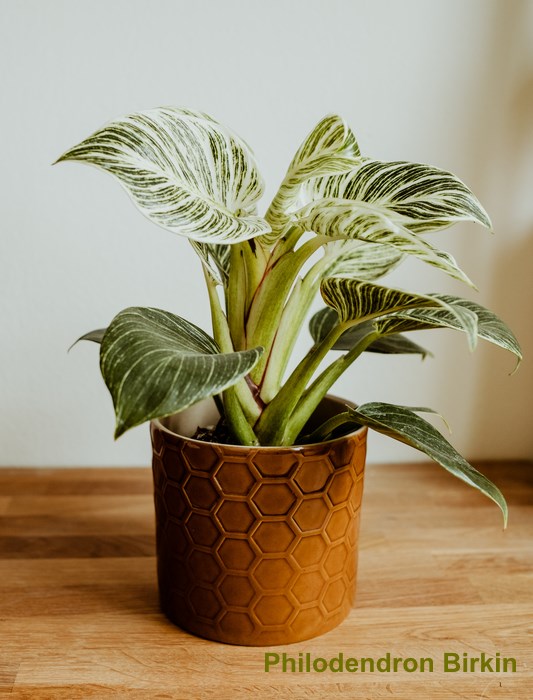Philodendron Birkin Care
This captivating newcomer is not only good looking, Philodendron Birkin care is a breeze.
It's easy to see why this newer hybrid is getting plenty of admiration from seasoned growers and new plant parents alike.
If you're looking for a compact plant, one that's practically care-free and decorative, too -- you've just found your ideal houseplant!
 Handsome pinstripe foliage makes Birkin a must-have houseplant. Photo © Catherine Ekkelboom White
Handsome pinstripe foliage makes Birkin a must-have houseplant. Photo © Catherine Ekkelboom WhiteVariegated houseplants are a super-hot trend now, and Philodendron Birkin does not disappoint. Handsome dark-green leaves sport white pinstripes that add style to any houseplant grouping, yet Birkin is a gem on its own, too.
Keep its leaves clean by gently wiping them with a damp cloth. Dusty foliage can interfere with photosynthesis. Besides, you want to admire those spectacular leaves.
How big does Birkin get? This mounding Philodendron is typically sold as a small plant, but will eventually reach about 1-ft tall. Those upright stems may sprawl out about as wide. You can show off a young plant by putting it on a plant stand.
Once rare and hard to find, this hybrid is now available at many garden centers and online nurseries. If you come across Birkin, buy it. Philodendron Birkin care is a cinch -- and you'll love giving this delightful houseplant a place in your home.
Birkin Houseplant Problems, Solutions and Answers
Yellow leaves? You over-watered. This is the most common way to kill a houseplant. See "Water" tips below. Use a planter with drainage holes to prevent soggy potting mix.
Brown leaf tips are caused by dry air. Indoor air can become extremely dry during the winter months, when furnaces are on and fireplaces are blazing. It's a good idea to use a cool-mist room humidifier near your tropical plants to make them feel at home.
Wondering when to repot? Spring is the best time to repot, when the plant is beginning its most vigorous time of growth. With Philodendron Birkin care should be taken to move up only one pot size (1-2 in/2.5-5 cm) larger. This plant grows best when its roots are a little snug in the pot. Use a heavy pot to keep it from toppling, with drainage holes to prevent soggy potting medium.
Is Philodendron Birkin poisonous? Yes, all Philodendrons contain insoluble calcium oxalate crystals, which are toxic to cats, dogs and people when ingested. However, a large amount of leaves would have to be eaten to cause serious illness.
Something bugging your plant? Not many pests bother Philodendrons, but there are a couple to watch for. Mealybugs look like white, cotton-like specks that will probably be grouped along the stems. Remove them with a cotton swab dipped in alcohol. Moist peaty potting mixes may attract fungus gnats. They look like tiny, black flies and hop or crawl on the potting mix. Multiplying quickly, they may move on to your other houseplants if they are not treated right away.
Philodendron Birkin Care
Origin: Hybrid of Philodendrons from Central and South America
Height: 1 ft (30 cm)
Light: Bright indirect light. Keep Philodendron Birkin plant in a bright location, but not in direct sun which can scorch its leaves. Give your plant a quarter turn every week or so to expose all sides to sunlight. Don't have a sunny window? It thrives under fluorescent light, making it an ideal office plant.
Water: Water thoroughly, then allow the top 1-2 inches (2.5-5 cm) to dry before watering again. Sticking your finger in the potting mix is one way to tell whether your plant needs watering; however, a houseplant moisture meter is more accurate. Over-watering will cause leaves to turn yellow and may ultimately lead to root rot. With Philodendron Birkin care should be taken to use room-temperature water, because cold water is a shock to this tropical houseplant.
Humidity: Tolerant of dry air, but this tropical likes humidity. Try to maintain 45% relative humidity or higher. Check out these easy ways to raise the humidity around your tropical plants. Brown leaf tips are a symptom of dry air.
Temperature: Average to warm room temperatures (70-80°F/21-27°C) is ideal year-round. This warm-natured Philodendron will tolerate a minimum of 60°F/16°C.
Soil: Peat-moss based potting mix with added perlite to prevent soggy potting mix.
Fertilizer: Feed every 6 weeks spring through fall with a high-nitrogen water-soluble fertilizer that includes micronutrients. Don't feed in winter, when growth is slower.
Propagation: Take stem cuttings from a mature plant; spring or summer is the best time to propagate because this is their most vigorous time of growth. Place the cutting in moist potting mix and keep the new cutting warm (around 70°F/21°C) in indirect light. Cuttings should root in about 3-4 weeks.


